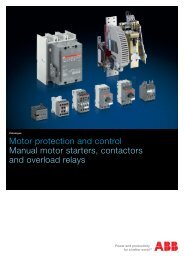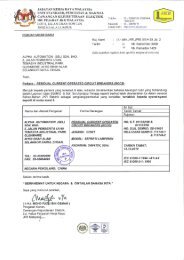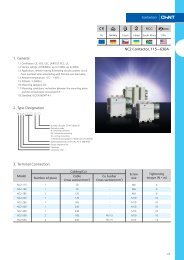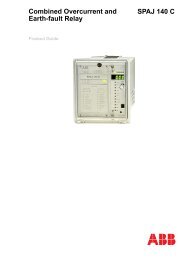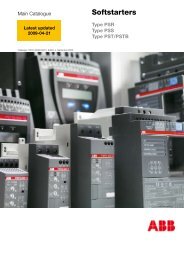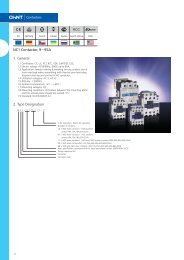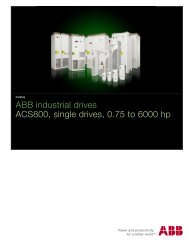Emax Low voltage air circuit-breakers - ABB Download Center
Emax Low voltage air circuit-breakers - ABB Download Center
Emax Low voltage air circuit-breakers - ABB Download Center
Create successful ePaper yourself
Turn your PDF publications into a flip-book with our unique Google optimized e-Paper software.
Primary and secondary distributionBack-up protectionBack-up protection is required by the IEC 60364-4-43 Standardsand Annex A of the IEC 60947-2 Standard, which allow the useof a protection device with breaking capacity lower than theprospective short-<strong>circuit</strong> current at the points where it is installed,provided that there is another protection device on the supplyside with the necessary breaking capacity. In this case, thecharacteristics of the two devices must be coordinated in sucha way that the specific energy let through by the combination isnot higher than that which can be withstood without damage bythe device on the load side, and by the protected conductors.In the diagram in the figure, <strong>circuit</strong>-breaker B, located on theload side of <strong>circuit</strong>-breaker A, can have a lower breaking capacitythan the prospective short-<strong>circuit</strong> current in the event ofa fault in “C”, if <strong>circuit</strong>-breaker A is able to satisfy both of thefollowing conditions:– it has a suitable breaking capacity (higher than or equal tothe prospective short-<strong>circuit</strong> current at its point of installationand obviously higher than the short-<strong>circuit</strong> current in “C”)– in the event of a fault in “C” with short-<strong>circuit</strong> values higherthan the breaking capacity of <strong>circuit</strong>-breaker B, <strong>circuit</strong>breakerA must provide a specific let-through energy limitingfunction, limiting it to a value that can be withstood by<strong>circuit</strong>-breaker B and by the protected conductors.A fault in “C” can therefore cause a double interruption, howeverthe back-up protection must ensure that B always tripswithin the limits of its breaking capacity.It is necessary to choose switchgear combinations that havebeen verified by laboratory tests for this type of protection. Thepossible combinations are specified in <strong>ABB</strong> SACE documentsand PC programs (Slide rule kits, DOCWin, etc.) and shownhere for SACE <strong>Emax</strong> <strong>circuit</strong>-<strong>breakers</strong>.Back-up protection is used in electrical installations in whichthere is no essential need for continuous operation: when thesupply-side <strong>circuit</strong>-breaker opens, it also excludes loads thatare not affected by the fault. Furthermore, the use of this type ofcoordination limits the size of the installation and consequentlyreduces costs.NoteBack-up protection can also be implementedon more than two levels: the figureabove shows an example of coordination onthree levels. In this case, the choices arecorrect if at least one of the two situationsbelow is satisfied:– the <strong>circuit</strong>-breaker furthest on the supplyside A is coordinated with both <strong>circuit</strong><strong>breakers</strong>B and C (coordination between<strong>circuit</strong>-<strong>breakers</strong> B and C is notnecessary);– each <strong>circuit</strong>-breaker is coordinated withthe <strong>circuit</strong>-breaker immediately to the loadside of it, i.e. the <strong>circuit</strong>-breaker furthestto the supply side A is coordinated withthe next one B, which is in turncoordinated with <strong>circuit</strong>-breaker C.1SDC200187F00011SDC200188F00016Table showing coordination for back-up protectionSupply-side <strong>circuit</strong>-breakerBreaking capacityE2L - E3L 130 [kA] (at 380/415 V)Load-side <strong>circuit</strong>-breakerBack-up valueT4N 65 [kAT4S - T5N - S6N - E1B - E2B 85 [kA]T4H - T5S/H - S6S/H - S7S/H - E1N - E2N 100 [kA]T4L - T5L130 [kA]<strong>ABB</strong> SACE 6/13




